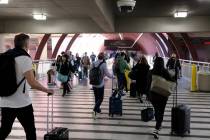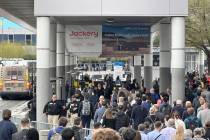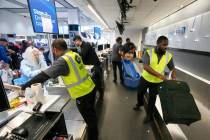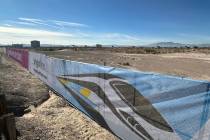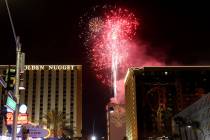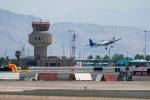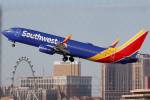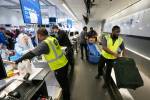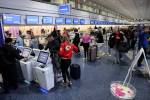Airports big and small try to court airlines at World Routes conference
After his 20-minute session with Hong Kong Express Airways on Monday, Scott Kichline realized that its fleet of 24 passenger airliners was probably not configured for direct flights to Las Vegas.
However, this was not a dry hole for Kichline, manager of commercial and business development at McCarran International Airport.
He explored with the airline’s executives the possibilities of closely timed and jointly marketed connections with domestic carriers for potential Hong Kong Express nonstops to San Francisco as a way to funnel more Asian visitors to the Strip.
And so it went at least a thousand times during the second day of the World Routes conference at the Las Vegas Convention Center, as airports big and small tried to woo airlines into sending a couple of planes their way.
The main arenas were the two sections of the exhibit floor with 355 tables reserved for airlines to hear the hurry-up pitches ended by a four-tone gong broadcast over the public address system.
Air Canada had scheduled 45 meetings over three days at just one of its four tables, said Vijay Bathija, vice president-commercial for the airline’s new Rouge leisure division. Rouge will make its local debut Oct. 27, displacing the current Air Canada service to Toronto.
The promise that such abbreviated introductions can result in expanded schedules has raised the World Routes profile among local and state officials far beyond what would be typical for a convention with only 2,800 attendees.
Gov. Brian Sandoval took 40 minutes to walk the floor with the media in tow in a day that included a meeting with Julian Adem Diaz, Mexico’s consul general in Las Vegas.
However, the track record for 10 previous World Routes hosts shows no pattern of accelerated passenger growth rates after the conference compared with before.
“If you come here, it is sensory overload,” said Sandoval, noting the booths from every continent except Antarctica.
In the middle of the floor, Beijing Capital International Airport had erected an elaborate red booth — a chalet in official jargon — even though the 81.9 million passengers it handled last year makes it only the second-busiest airport in the world.
Across the aisle, Reno-Tahoe International Airport opted for a much more low-key approach, with some outdoor furniture, potted plants, poster-sized photos and representatives in hiking garb.
Not surprisingly, it was one of Sandoval’s stops as he held his hands over a metal fire pit as if to warm them, even though it held only a few pieces of dry wood.
The airport will take the help anywhere it can.
Since 2007, the passenger counts have dropped 31 percent to 3.5 million last year, with the declines continuing through August.
Particularly among international airlines, Reno-Tahoe has to fight the perception that it is just a distant suburb of Las Vegas that does not need separate flights, said air service marketing manager Rebecca Venis.
To try to counter that, “we present a compelling business case to the airlines,” Venis said. “We show them what makes us unique, such as our location, the cluster of skiing and the low landing fees.”
However, she said, many other airports bring variations of the same message.
“In a setting like this, it is tough to sift through the clutter,” Venis said.
This was the first time World Routes has come to the United States, and many small and midsized cities sent contingents for the first time.
So they compete not only against one another but also with a long list of foreign locales.
While Reno-Tahoe handed out small wool blankets to highlight its visitor appeal and screen-cleaner cloths with an air cargo message, it chose not to compete with the numerous open bars that dotted the floor.
Contact reporter Tim O’Reiley at toreiley@reviewjournal.com or at 702-387-5290.






















